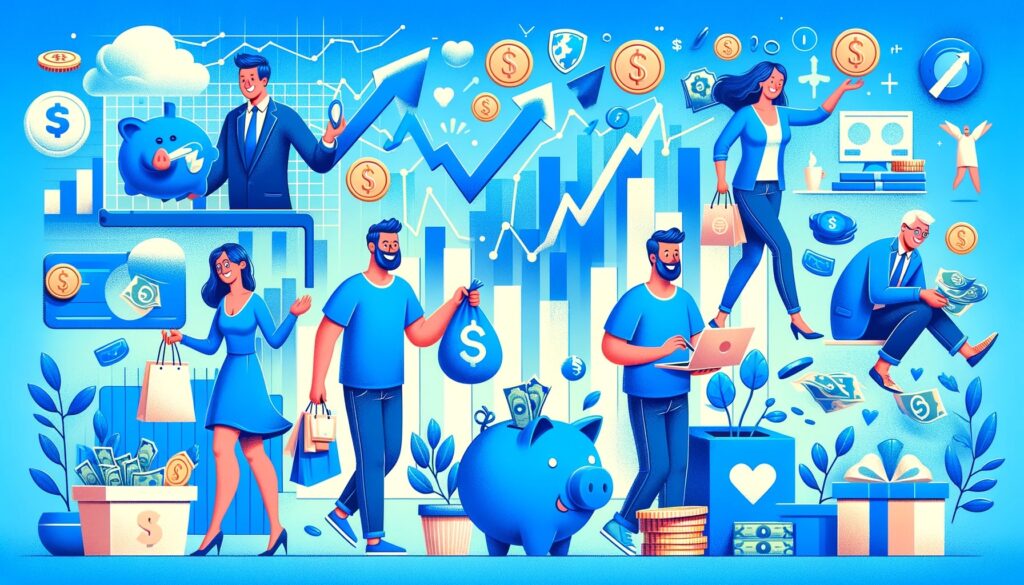
Inflation – ugh, it’s hard to even think about! But unfortunately, in 2023, it’s still something you need to think about.
High inflation is still rocking the U.S. economy. And to stay on top of it, you need to understand how it works, and what tools you can use against it.
In this article, you’ll be exposed to both. You’ll see what causes inflation, what a “good” amount looks like, why things have been so rough recently, where we may be headed, and what actions you can take to protect yourself.
Let’s get started.
What Exactly Is Inflation?
Inflation is simply a rise in prices within an economy. And as a consumer, you experience its effects through a loss of purchasing power.
Inflation is commonly measured through the use of a Consumer Price Index (CPI). This index tracks average price changes overtime for a given market basket of goods and services (e.g. food, energy, all goods, etc.), and expresses the increases as a percentage.1
What Is The Main Cause of Inflation?
The main cause of inflation is an increase in the money supply of an economy. However, this increase can happen in a variety of ways. From a governmental standpoint, those in power can induce inflation through:
- The printing of new money
- The legal devaluation of existing currency
- The loaning of money through government bonds
Regardless of which action the government takes, the ultimate effect is the same – your money won’t go as far as it used to. That said, the market itself can drive inflation too. And you’ll see that happen through demand-pull inflation, cost-push inflation, and built-in inflation.
Demand-Pull Inflation
Demand-pull inflation shows up when demand for a product or service outpaces the supply.2 This results in shortages, and thus an increase in the price of the scarcer product or service being demanded.
A recent example of demand-pull inflation was seen during the pandemic. With factors like work-from-home conditions, less places to spend money, and higher personal savings rates, demand for houses began to skyrocket. And since housing supply couldn’t keep up with the demand, we saw home average home prices rapidly inflate in price.
Cost-Push Inflation
Cost-push inflation happens when the supply of goods becomes limited, but the demand for it stays the same.3
You may have experienced cost-push inflation at the gas pump not too long ago. Shortly after the Russian-Ukrainian war began, the U.S. banned the importation of Russian oil.4 This lowered the supply of oil, and affected related goods like gasoline. Americans still needed to fuel up their vehicles, but had to stomach much higher prices to do so.
Built-In Inflation
Built-in inflation comes as a result of the expectation that inflation is a normal phenomenon (see next section).5 People expect that the costs of goods and services will rise overtime, and as a result continuously demand to be paid more and more to maintain their standards of living.
With a quick look at the history books, you’ll see that this holds true. For example, back in 1908, Ford Motor Company was selling its Model T’s for between $260 – $850 dollars, and you could grab a bottle of Coke for only a nickel.6 7
What Inflation Rate Is Good?
A healthy inflation rate is ~2%.8 Some inflation can actually spur healthy economic growth. That’s because with more money in the economy, there’s typically more spending (i.e. demand), and more production (i.e. supply) is needed to meet the demand.
However, the inflation rates we’ve seen since early 2021 have far exceeded this healthy threshold. And even set a 40-year high record in mid-2022.9
Inflation’s 40-Year High
Inflation reached record-setting highs on multiple occasions in 2022. But in June, 2022 the inflation rate broke a staggering 9%, which set the bar as the highest it’s been in four decades.10
Since then, inflation has dropped, but has continued to remain well above its target “healthy” threshold of ~2%. And unfortunately, it’s looking like bracing for more of the same isn’t such a bad idea.
How Long Will Inflation Last?
Don’t be fooled by the talking heads in the media. The true answer to this question is nobody knows for sure. That said, it’s still worth hearing from the experts. Just keep in mind their predictions are not definitive.
The Federal Reserve (Fed), uses core personal consumption expenditures (PCE) as its preferred measurement of inflation. That’s because it removes food and energy prices that are inherently more volatile.11
Economists at the Fed are predicting inflation (based on core PCE) to fall to 3.1% in 2023. But it may take out till 2025 to get closer to the healthy ~2% mark based on a recent SEP report.12
How Can You Hedge Against Inflation?
It’s always best to focus on the variables you can control. Especially when things seem so out of control!
So when it comes to hedging against inflation, look at the financial tools you have at your disposal. The two biggest helpers are going to be your budget and your investments, and they work together.
Review Your Budget
Your budget clarifies what’s coming in and what’s going out. And maintaining a proper one is vital in building your retirement momentum. That’s because it consistently identifies the financial habits that are, and are not serving you in the present moment.
Some areas you may want to double-check when reviewing your budget include:
- Entertainment Subscriptions: Are you getting enough value out of your entertainment subscriptions? Consider canceling ones you hardly/never use.
- Eating Out: Trips to the grocery store will likely be cheaper than ones to a restaurant. And you can make it easier on yourself by learning to cook things you actually want to eat!
- Big-Ticket Items: Is that luxury car, vacation, or accessory affordable right now? Because you don’t want something intended to bring joy to bring long-term anxiety instead.
TIP: Your budget is not the enemy! Use it to identify what you want to cut. Don’t force yourself to ditch what you love. Look for spending habits that don’t align with your values first.
Recalibrate Your Investments
Your budget can help free up more cash to be put towards investments. And that’s huge, because recalibrating your investments can dramatically limit the impact inflation is able to have on your wealth.
The types of investments worth learning more about:
- Equities: Stocks are able to offer long-term returns that outpace even the record breaking inflation we’ve seen recently. And with the right strategy, you can remain consistent with a diversified plan that can compound your wealth at an accelerated rate over time. However, short-term volatility (both up and down) is also a common experience owning equities.
- Money Market Funds and/or CDs: Generally speaking these investment asset classes provide a much lower rate of return. And they’re not going to bolster your wealth against inflation. That said, they still can have their place in holding your emergency cash.
- Real Estate: Generally speaking, the prices of homes are known to appreciate in the long run. And if you’re in a position to afford one, a rental property can provide additional streams of more passive income. But extensive considerations (e.g. tax consequences, cash flow, maintenance, etc.) need to be considered before closing on anything.
- Bonds: Certain bonds (ex: Treasury Inflation-Protected Securities) could offer an investment vehicle that essentially aims to neutralize the impacts of inflation. You may not be earning outpacing returns, but your purchasing power could be maintained.
Please Note: Use of any of the above investments should be aligned with your long-term investment plan. Each has their own pros and cons, and needs proper due diligence before an adjustment is made. And we can help you.
How Snowpine Wealth Can Help You Further
At Snowpine Wealth we understand how nerve-wracking inflation can be. But we also understand the strategies you can use to hedge against it.
In 2023, it’s still worth understanding, and working against high, unhealthy inflation. And as your financial thinking partner, we’ll work to create the right budget, strategy, and investment portfolio to help build your wealth.
If you’re looking to stay in a growth-oriented mindset, we’re here to help you. Whenever you’re ready to start, give us a call at 801-534-4463, or book your complimentary consultation.
Securities and advisory services offered through Commonwealth Financial Network®, Member FINRA/SIPC, a Registered Investment Advisor. Fixed insurance products and services not offered through Commonwealth Financial Network®.
References:
- https://www.bls.gov/cpi/
- https://www.investopedia.com/terms/d/demandpullinflation.asp
- https://www.investopedia.com/terms/c/costpushinflation.asp
- https://www.whitehouse.gov/briefing-room/statements-releases/2022/03/08/fact-sheet-un ited-states-bans-imports-of-russian-oil-liquefied-natural-gas-and-coal/
- https://www.investopedia.com/terms/i/inflation.asp
- https://corporate.ford.com/articles/history/the-model-t.html
- https://www.npr.org/sections/money/2012/11/15/165143816/why-coke-cost-a-nickel-for-7 0-years
- https://www.thebalancemoney.com/current-u-s-inflation-rate-statistics-and-news-330613 9#:~:tex
- https://www.usinflationcalculator.com/inflation/current-inflation-rates/#:~:text=The%20ann ual%20inflation%20rate%20for,ET
- https://www.bls.gov/opub/ted/2022/consumer-prices-up-9-1-percent-over-the-year-ended-june-2022-largest-increase-in-40-years.htm#:~:text=Consumer%20prices%20up%209.1%20percent,U.S.%20Bureau%20of%20Labor%20Statistics&text=The%20.,gov%20mea ns%20it’s%20official.
- https://www.forbes.com/advisor/investing/peak-inflation-are-we-there-yet/
- https://www.forbes.com/advisor/investing/inflation-outlook-2023/

